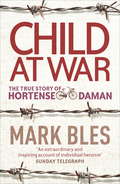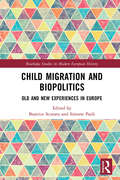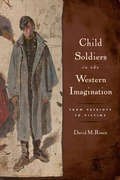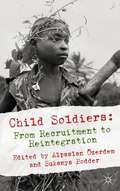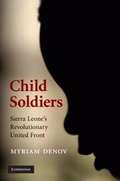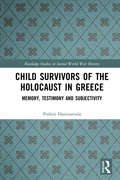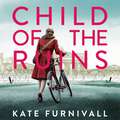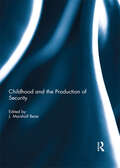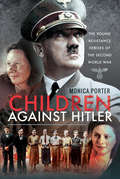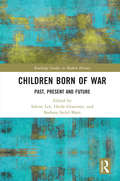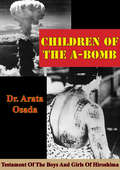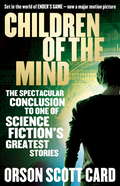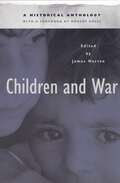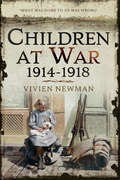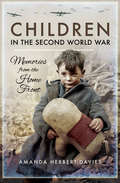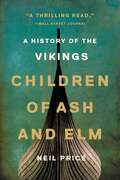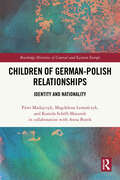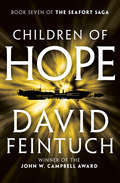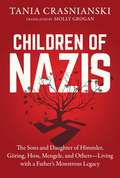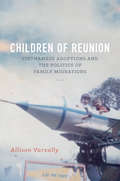- Table View
- List View
Child At War: The True Story of Hortense Daman
by Mark Whitcombe-PowerAt the age of fifteen Hortense Daman embarked on a secret career. In her German-occupied hometown of Louvain, Belgium, she joined the resistance, first as a courier, then as a fighter. She ran terrifying risks, smuggling explosives in her bicycle pannier past German soldiers and helping allied airmen to safety. It couldn't last; and it didn't. She was later betrayed, imprisoned and condemned to death. Separated from her family, she - and later her mother - was sent to the 'women's inferno' - Ravensbruck concentration camp. Subjected to horrific medical experiments, she endured starvation, illness, freezing temperatures, and she watched helplessly as thousands died around her. Yet, against unimaginable odds, she survived. Child at War is the true, extraordinary and often shocking account of the years that saw Hortense change from the innocent schoolgirl to freedom fighter and ultimately to survivor of the most atrocious regime the world has ever seen.
Child Migration and Biopolitics: Old and New Experiences in Europe (Routledge Studies in Modern European History)
by Beatrice ScutaruThis book provides a fresh interdisciplinary analysis into the lives of migrant children and youth over the course of the twentieth century and up to the present day. Adopting biopolitics as a theoretical framework, the authors examine the complex interplay of structures, contexts and relations of power which influence the evolution of child migration across national borders. The volume also investigates children’s experiences, views, priorities and expectations and their roles as active agents in their own migration. Using a great variety of methodologies (archival research, ethnographic observation, interviews) and sources (drawings, documents produced by governments and experts, films and press), the authors provide richly documented case studies which cover a wide geographical area within Europe, both West (Belgium, France, Germany) and East (Romania, Russia, Ukraine), South (Italy, Portugal, Turkey) and North (Sweden), enabling a deep understanding of the diversity of migrant childhoods in the European context.
Child Soldiers in the Western Imagination
by David M RosenWhen we hear the term "child soldiers," most Americans imagine innocent victims roped into bloody conflicts in distant war-torn lands like Sudan and Sierra Leone. Yet our own history is filled with examples of children involved in warfare--from adolescent prisoner of war Andrew Jackson to Civil War drummer boys--who were once viewed as symbols of national pride rather than signs of human degradation. In this daring new study, anthropologist David M. Rosen investigates why our cultural perception of the child soldier has changed so radically over the past two centuries. Child Soldiers in the Western Imagination reveals how Western conceptions of childhood as a uniquely vulnerable and innocent state are a relatively recent invention. Furthermore, Rosen offers an illuminating history of how human rights organizations drew upon these sentiments to create the very term "child soldier," which they presented as the embodiment of war's human cost. Filled with shocking historical accounts and facts--and revealing the reasons why one cannot spell "infantry" without "infant"--Child Soldiers in the Western Imagination seeks to shake us out of our pervasive historical amnesia. It challenges us to stop looking at child soldiers through a biased set of idealized assumptions about childhood, so that we can better address the realities of adolescents and pre-adolescents in combat. Presenting informative facts while examining fictional representations of the child soldier in popular culture, this book is both eye-opening and thought-provoking.
Child Soldiers: From Recruitment to Reintegration
by Alpaslan �zerdem Sukanya PodderThis book examines the complex and under-researched relationship between recruitment experiences and reintegration outcomes for child soldiers. It looks at time spent in the group, issues of cohesion, identification, affiliation, membership and the post demobilization experience of return, and resettlement.
Child Soldiers: Sierra Leone's Revolutionary United Front
by Myriam DenovTragically, violence and armed conflict have become commonplace in the lives of many children around the world. Not only have millions of children been forced to witness war and its atrocities, but many are drawn into conflict as active participants. Nowhere has this been more evident than in Sierra Leone during its 11-year civil war. Drawing upon in-depth interviews and focus groups with former child soldiers of Sierra Leone's rebel Revolutionary United Front, Myriam Denov compassionately examines how child soldiers are initiated into the complex world of violence and armed conflict. She also explores the ways in which the children leave this world of violence and the challenges they face when trying to renegotiate their lives and self-concepts in the aftermath of war. The narratives of the Sierra Leonean youth demonstrate that their life histories defy the narrow and limiting portrayals presented by the media and popular discourse.
Child Survivors of the Holocaust in Greece: Memory, Testimony and Subjectivity (Routledge Studies in Second World War History)
by Pothiti HantzaroulaA historical investigation of children’s memory of the Holocaust in Greece illustrates that age, generation and geographical background shaped postwar Jewish identities. The examination of children’s narratives deposited in the era of digital archives enables an understanding of the age-specific construction of the memory of genocide, which shakes established assumptions about the memory of the Holocaust. In the context of a global Holocaust memory established through testimony archives, the present research constructs a genealogy of the testimonial culture in Greece by framing the rich source of written and oral testimonies in the political discourses and public memory of the aftermath of the Second World War. The testimonies of former hidden children and child survivors of concentration camps illuminate the questions that haunted postwar attempts to reconstruct communities, related to the specific evolution of genocide in Greece and to the rising anti-Semitism of postwar Greece. As an oral history of child survivors of the Holocaust, the book will be of interest to researchers in the fields of the history of childhood, Jewish studies, memory studies and Holocaust and genocide studies.
Child of Two Worlds (Star Trek: The Original Series)
by Greg CoxAn all-new Star Trek novel from New York Times bestselling author Greg Cox, taking place in the blockbuster Original Series era!The year is 2255, not long after the events of the Original Series episode “The Cage.” A young Spock is science officer on the U.S.S. Enterprise, under the command of Captain Christopher Pike, when an outbreak of deadly Rigelian fever threatens the crew. Reviewing the Starfleet medical database, Dr. Phillip Boyce comes up with a highly experimental and untested new treatment that might save the crew. Just one problem: it requires a rare mineral substance, ryetalyn, which is not easily obtained…except on a remote alien colony near the Klingon border. But borders are somewhat blurry in this part of galaxy. Pike will need to tread carefully in order to avoid provoking an armed conflict with the Klingons—or starting an all-out war. ™, ®, & © 2015 CBS Studios, Inc. STAR TREK and related marks and logos are trademarks of CBS Studios, Inc. All Rights Reserved.
Child of the Ruins: a gripping, heart-breaking and unforgettable World War Two historical thriller
by Kate FurnivallAnna and Ingrid have survived World War II. Now they must live through the Berlin airlifts.Evocative and unforgettable, CHILD OF THE RUINS is set during the Berlin air lifts of 1948 and written by one of the most brilliant writers of historical fiction in the UK.People are disappearing. I spoke to my neighbour yesterday, we laughed at some nonsense, and today he is gone. We only discovered he was missing because the dog wouldn't stop howling and we all knew he would never leave his beloved pet. So I am careful, extremely careful.Two families divided by war.An entire city on the edge of disaster.1948, Berlin. World War II has ended and there is supposed to be peace; but Russian troops have closed all access to the city. Roads, railway lines and waterways are blocked and two million people are trapped, relying on airlifts of food, water and medicine to survive. The sharp eyes of the Russian state police watch everything; no one can be trusted.Anna and Ingrid are both searching for answers - and revenge - in the messy aftermath of war. They understand that survival comes only by knowing what to trade: food; medicine; heirlooms; secrets. Both are living in the shadows of a city where the line between right and wrong has become dangerously blurred. But they cannot give up in the search for a lost child ... Praise for Kate Furnivall's writing:'Kate Furnivall has a talent for creating places and characters who stay with you long after you have read the final word' JANE CORRY'Hugely ambitious and atmospheric' KATE MOSSE'Fast-paced with a sinister edge' THE TIMES(P)2023 Hodder & Stoughton Limited
Child of the Ruins: a gripping, heart-breaking and unforgettable World War Two historical thriller
by Kate Furnivall'A poignant love story' THE iTwo families divided by war.An entire city on the edge of disaster.'I was blown away not just by the gripping story, which had my heart thumping at times, but the sheer eloquence of writing. It is a story of the strength of the human spirit, and of love which will not be defeated. I know I will be recommending it to everyone' LESLEY PEARSE1948, Berlin. World War II has ended and there is supposed to be peace; but Russian troops have closed all access to the city. Roads, railway lines and waterways are blocked and two million people are trapped, relying on airlifts of food, water and medicine to survive. The sharp eyes of the Russian state police watch everything; no one can be trusted.Anna and Ingrid are both searching for answers - and revenge - in the messy aftermath of war. They understand that survival comes only by knowing what to trade: food; medicine; heirlooms; secrets. Both are living in the shadows of a city where the line between right and wrong has become dangerously blurred. But they cannot give up in the search for a lost child . . . 'An absolute triumph' DINAH JEFFERIES'Vivid, brave and suspenseful' RACHEL HORE'I defy anyone not to read beyond the first killer sentence' JANE CORRY'A harrowing and compelling portrait of Berlin in the aftermath of World War Two, told through the interconnecting stories of two courageous women struggling to survive in the rubble of their war-torn city' FIONA VALPY*** READERS LOVE THIS NOVEL! ***'The plot is exciting and fast paced. Thought-provoking and multi-layered as well as thoroughly entertaining. A perfect read' 'Furnivall masterfully captures the history of a divided Berlin in the aftermath of WW2''This novel draws you in with its incredibly well-researched historical fiction and tenacious female leads''A sweeping historical drama that's powerful and tense, full of espionage, making you feel like you're living in post-war Berlin... Beautifully written''This was such an emotive and immersive read that certainly stayed with me long after finishing the pages ... I literally couldn't put this book down. A brilliant story''Such an emotional, powerful, well-written, totally gripping book. I was blown away'
Child of the Ruins: a gripping, heart-breaking and unforgettable World War Two historical thriller
by Kate Furnivall'A poignant love story' THE iTwo families divided by war.An entire city on the edge of disaster.'I was blown away not just by the gripping story, which had my heart thumping at times, but the sheer eloquence of writing. It is a story of the strength of the human spirit, and of love which will not be defeated. I know I will be recommending it to everyone' LESLEY PEARSE1948, Berlin. World War II has ended and there is supposed to be peace; but Russian troops have closed all access to the city. Roads, railway lines and waterways are blocked and two million people are trapped, relying on airlifts of food, water and medicine to survive. The sharp eyes of the Russian state police watch everything; no one can be trusted.Anna and Ingrid are both searching for answers - and revenge - in the messy aftermath of war. They understand that survival comes only by knowing what to trade: food; medicine; heirlooms; secrets. Both are living in the shadows of a city where the line between right and wrong has become dangerously blurred. But they cannot give up in the search for a lost child . . . 'An absolute triumph' DINAH JEFFERIES'Vivid, brave and suspenseful' RACHEL HORE'I defy anyone not to read beyond the first killer sentence' JANE CORRY'A harrowing and compelling portrait of Berlin in the aftermath of World War Two, told through the interconnecting stories of two courageous women struggling to survive in the rubble of their war-torn city' FIONA VALPY*** READERS LOVE THIS NOVEL! ***'The plot is exciting and fast paced. Thought-provoking and multi-layered as well as thoroughly entertaining. A perfect read' 'Furnivall masterfully captures the history of a divided Berlin in the aftermath of WW2''This novel draws you in with its incredibly well-researched historical fiction and tenacious female leads''A sweeping historical drama that's powerful and tense, full of espionage, making you feel like you're living in post-war Berlin... Beautifully written''This was such an emotive and immersive read that certainly stayed with me long after finishing the pages ... I literally couldn't put this book down. A brilliant story''Such an emotional, powerful, well-written, totally gripping book. I was blown away'
Childhood and the Production of Security
by J. Marshall BeierResponding to security scholars’ puzzling dearth of attention to children and childhoods, the contributors to this volume reveal the ways in which they not only are already present in security discourses but are actually indispensable to them and to the political projects they make possible. From zones of conflict to everyday life contexts in the (post)industrial Global North, dominant ideas about childhood work to regulate the constitution of political subjects whilst variously enabling and foreclosing a wide range of political possibilities. Whether on the battlefields of Syria, in the halls of the UN, or the conceptual musings of disciplinary Security Studies, claims about or ostensibly on behalf of children are ubiquitous. Recognizing children as engaged political subjects, however, challenges us to bring a sustained critical gaze to the discursive and semiotic deployments of children and childhood in projects not of their making as well as to the ways in which power circulates through and around them. This book was originally published as a special issue of Critical Studies on Security.
Children Against Hitler: The Young Resistance Heroes of the Second World War
by Monica Porter&“A fitting memorial to the children who risked (and so often lost) their lives in resisting the Nazi war machine . . . extraordinary, unique, informative.&” —Midwest Book Review Readers of all generations have grown up on The Silver Sword, Ian Serraillier&’s bestselling tale of children under wartime occupation, but few know the real life stories of the children and teenagers who went further and actually stood up to the Nazis. Here, for the first time, Monica Porter gathers together their stories from many corners of occupied Europe, showing how in a variety of audacious and inventive ways children as young as six resisted the Nazi menace, risking and sometimes even sacrificing their brief lives in the process: a heroism that until now has largely gone unsung. These courageous youngsters came from all classes and backgrounds. There were high school dropouts and social misfits, brainy bookworms, the children of farmers and factory workers. Some lost their entire families to the war, yet fought on alone. Often more adept and fearless at resistance than adults, they exuded an air of guilelessness and could slip more easily under the Nazi radar. But as nets tightened, many were captured, tortured or imprisoned, some paying the highest price—a life cut short by execution before they had even turned eighteen. These children were motivated by different ideals; patriotism, political conviction, their Christian beliefs, or revulsion at the brutality of the Third Reich. But what united them was their determination to strike back at an enemy which had deprived them of their freedom, their dignity—and their childhood.
Children Born of War: Past, Present and Future (Routledge Studies in Modern History)
by Sabine LeeThis volume presents research from an international, interdisciplinary, and intersectoral research project in which 15 doctoral researchers explored a range of issues related to the life-course experiences of children born of war in 20th-century conflicts. Children Born of War (CBOW), children fathered by foreign soldiers and born to local mothers during and after armed conflicts, have long been neglected in the research of the social consequences of war. Based on research projects completed under the auspices of the Horizon2020-funded international and interdisciplinary research and training network CHIBOW (www.chibow.org), this book examines the psychological and social impact of war on these children. It focusses on three separate but interrelated themes: firstly, it explores methodological and ethical issues related to research with war-affected populations in general and children born of war in particular. Secondly, it presents innovative historical research focussing specifically on geopolitical areas that have hitherto been unexplored; and thirdly, it addresses, from a psychological and psychiatric perspective, the challenges faced by children born of war in post-conflict communities, including stigmatisation, discrimination, within the significant context of identity formation when faced with contested memories of volatile post-war experiences. The book offers an insight into the social consequences of war for those children associated with the ‘enemy’ by virtue of their direct biological link.
Children Of The A-Bomb: Bomb, The Testament Of The Boys And Girls Of Hiroshima
by Arata Osada"Children of the A-Bomb" is a collection of 67 testimonies of Hiroshima survivors culled from a total of more than 2,000, detailing the experiences of these innocent victims on 6th August 1945, as painfully remembered six years later, on what, in the Japanese way of counting, was the seventh anniversary of the event.The book is divided into four sections, according to the grade of the writers in 1951: from grammar to junior, senior and high school, including three undergraduate college students. The length of the testimonies varies from one to ten pages, the longer ones of course being concentrated in the latter half of the book. And though much of the material focuses on the immediate aftermath of the bombing, some of the writers also cover the days and sometimes weeks that followed, insofar as they were affected by the bomb, or perpetuated the victims' misery with their litany of typhoons, starvation, and radiation sickness and death.--Jean-Francois Virey
Children Of The Mind: Book 4 of the Ender Saga (Ender Saga #4)
by Orson Scott CardAchieves and delivers more than almost anything else within the science fiction genre, Ender's Game is a contemporary classic - New York Times'Full of surprises...Intense is the word for Orson Scott Card's ENDER'S GAME' - New York TimesThe planet Lusitania is home to three sentient species: the Pequeninos; a large colony of humans; and the Hive Queen, brought there by Ender. But once again the human race has grown fearful; the Starways Congress has gathered a fleet to destroy Lusitania.Jane, the evolved computer intelligence, can save the three sentient races of Lusitania. She has learned how to move ships outside the universe, and then instantly back to a different world, abolishing the light-speed limit. But it takes all the processing power available to her, and the Starways Congress is shutting down the Net, world by world. Soon Jane will not be able to move the ships. Ender's children must save her if they are to save themselves.The dazzling Ender series, which has changed the face of science fiction, concludes.Books by Orson Scott Card:Alvin Maker novelsSeventh SonRed ProphetPrentice AlvinAlvin JourneymanHeartfireThe Crystal CityEnder Wiggin SagaEnder's GameSpeaker for the DeadXenocideChildren of the MindEnder in Exile HomecomingThe Memory of the EarthThe Call of the EarthThe Ships of the EarthEarthfallEarthbornFirst Formic War (with Aaron Johnston)Earth UnawareEarth AfireEarth Awakens
Children and War: A Historical Anthology
by James Marten"This anthology is breathtaking in its geographic and temporal sweep."-Canadian Journal of History The American media has recently "discovered" children's experiences in present-day wars. A week-long series on the plight of child soldiers in Africa and Latin America was published in Newsday and newspapers have decried the U.S. government's reluctance to sign a United Nations treaty outlawing the use of under-age soldiers. These and numerous other stories and programs have shown that the number of children impacted by war as victims, casualties, and participants has mounted drastically during the last few decades. Although the scale on which children are affected by war may be greater today than at any time since the world wars of the twentieth century, children have been a part of conflict since the beginning of warfare. Children and War shows that boys and girls have routinely contributed to home front war efforts, armies have accepted under-aged soldiers for centuries, and war-time experiences have always affected the ways in which grown-up children of war perceive themselves and their societies. The essays in this collection range from explorations of childhood during the American Revolution and of the writings of free black children during the Civil War to children's home front war efforts during World War II, representations of war and defeat in Japanese children's magazines, and growing up in war-torn Liberia. Children and War provides a historical context for two centuries of children's multi-faceted involvement with war.
Children at War, 1914–1918: It's My War Too!
by Vivien NewmanThe author of We Also Served examines what life was like for children during World War I. For most British readers, the phrase &“children during the war&” conjures up images of the evacuees of the Second World War. Somehow, surprisingly, the children of the Great War have been largely and unjustifiably overlooked. However, this book takes readers to the heart of the Children&’s War 1914-1918. The age range covered, from birth to 17 years, as well as the richness of children&’s own writings and the breadth of English, French, and German primary and secondary sources, allows readers to experience wartime childhood and adolescence from multiple, multi-national standpoints. These include: British infants in the nursery; German children at school; French and Belgian youngsters living with the enemy in their occupied homelands; Australian girls and boys knitting socks for General Birdwood, (Commander-in-Chief of the Australian Imperial Force); Girl Guides working for MI5; youthful Ukrainian/Canadians wrongfully interned; German children held as prisoners of war in Siberia; teenage deckhands on the Lusitania; not to mention the rebellious underage Cossack girl who served throughout the war on the Eastern Front, as well as the youngest living recipient of the VC. At times humorous, at others terrifying, this book totally alters perceptions of what it was like to be young in the First World War. Readers will marvel at children&’s courage, ingenuity, patriotism, and pacifism, and wholeheartedly agree with the child who stated, &“What was done to us was wrong.&”
Children in the Second World War: Memories from the Home Front
by Amanda Herbert-Davies&“Stunning photographs&” and firsthand accounts propel a book that &“brings together the memories of more than 200 child survivors of the Blitz&” (Daily Mail). It was not just the upheaval caused by evacuation and the blitzes that changed a generation&’s childhood, it was how war pervaded every aspect of life. From dodging bombs by bicycle and patrolling the parish with the vicar&’s WWI pistol, to post air raid naps in school and being carried out of the rubble as the family&’s sole survivor, children experienced life in the war zone that was Britain. This reality, the reality of a life spent growing up during the Second World War, is best told through the eyes of the children who experienced it firsthand. Children in the Second World War unites the memories of over two hundred child veterans to tell the tragic and the remarkable stories of life, and of youth, during the war. Each veteran gives a unique insight into a childhood that was unlike any that came before or after. This book poignantly illustrates the presence of death and perseverance in the lives of children through this tumultuous period. Each account enlightens and touches the reader, shedding light on what it was really like on the home front during the Second World War.
Children of Ash and Elm: A History of the Vikings
by Neil PriceThe definitive history of the Vikings -- from arts and culture to politics and cosmology -- by a distinguished archaeologist with decades of expertiseThe Viking Age -- from 750 to 1050 -- saw an unprecedented expansion of the Scandinavian peoples into the wider world. As traders and raiders, explorers and colonists, they ranged from eastern North America to the Asian steppe. But for centuries, the Vikings have been seen through the eyes of others, distorted to suit the tastes of medieval clerics and Elizabethan playwrights, Victorian imperialists, Nazis, and more. None of these appropriations capture the real Vikings, or the richness and sophistication of their culture.Based on the latest archaeological and textual evidence, Children of Ash and Elm tells the story of the Vikings on their own terms: their politics, their cosmology and religion, their material world. Known today for a stereotype of maritime violence, the Vikings exported new ideas, technologies, beliefs, and practices to the lands they discovered and the peoples they encountered, and in the process were themselves changed. From Eirík Bloodaxe, who fought his way to a kingdom, to Gudrid Thorbjarnardóttir, the most traveled woman in the world, Children of Ash and Elm is the definitive history of the Vikings and their time.
Children of German-Polish Relationships: Identity and Nationality (Routledge Histories of Central and Eastern Europe)
by Piotr Madajczyk Magdalena Lemańczyk Kamila Schöll-MazurekThis book analyzes the process of national identity formation and identification of children born into formal and informal Polish-German relationships in Poland and Germany, and how that process is impacted by their upbringing at the intersection of two cultures.The sociological-historical approach explores a wide range of processes in interethnic couples related to the case at hand, such as migration, acculturation, and assimilation, as well as integration and increased participation in the structures of the host country, ties with the country of origin, generational changes and decreasing knowledge of the native tongue, and developments affecting mixed partnerships and their children. Taking an original approach to its focus on the long-term relationships between bilingualism and biculturalism and their impact on national identity and identification, the book considers the future and significance of binational and interethnic families and their children in the European integration process and European identity.This volume will appeal to sociologists, historians, political scientists, anthropologists, and linguists, and especially to students and scholars interested in the relations between national, linguistic, and political matters.
Children of Hope: Fisherman's Hope, Voices Of Hope, Patriarch's Hope, And Children Of Hope (The Seafort Saga #7)
by David FeintuchThe Seafort Saga continues with the shocking return of the predatory aliens and a powerful and unexpected new ally for Nick SeafortThe planet of Hope Nation has always loomed large in Nicholas Seafort&’s life. It was there that he built a name for himself, saving the planet from civil war and from the insatiable, fishlike aliens. But not everyone in that colony appreciated Seafort&’s efforts. Randy Carr, son of Seafort&’s old friend Derek Carr, blames him for his father&’s death and wants Seafort to pay for this bitter loss. Trouble brews for Seafort on Earth and on Hope Nation. A religious group called the Patriarchs fight to gain political control of Earth. The aliens suddenly reappear with an astonishing claim: They have peaceful intentions. As the aliens and their new human allies advance on Earth, hoping to calm its civil unrest, Nick Seafort must fight for the planet&’s future one final time.
Children of Nazis: The Sons and Daughters of Himmler, Göring, Höss, Mengele, and Others— Living with a Father's Monstrous Legacy
by Tania CrasnianskiIn 1940, the German sons and daughters of great Nazi dignitaries Himmler, Göring, Hess, Frank, Bormann, Speer, and Mengele were children of privilege at four, five, or ten years old, surrounded by affectionate, all-powerful parents. Although innocent and unaware of what was happening at the time, they eventually discovered the extent of their father’s occupations: These men—their fathers who were capable of loving their children and receiving love in return—were leaders of the Third Reich, and would later be convicted as monstrous war criminals. For these children, the German defeat was an earth-shattering source of family rupture, the end of opulence, and the jarring discovery of Hitler’s atrocities. How did the offspring of these leaders deal with the aftermath of the war and the skeletons that would haunt them forever? Some chose to disown their past. Others did not. Some condemned their fathers; others worshipped them unconditionally to the end. In this enlightening book, Tania Crasnianski examines the responsibility of eight descendants of Nazi notables, caught somewhere between stigmatization, worship, and amnesia. By tracing the unique experiences of these children, she probes at the relationship between them and their fathers and examines the idea of how responsibility for the fault is continually borne by the descendants.
Children of Reunion: Vietnamese Adoptions and the Politics of Family Migrations
by Allison VarzallyIn 1961, the U.S. government established the first formalized provisions for intercountry adoption just as it was expanding America's involvement with Vietnam. Adoption became an increasingly important portal of entry into American society for Vietnamese and Amerasian children, raising questions about the United States' obligations to refugees and the nature of the family during an era of heightened anxiety about U.S. global interventions. Whether adopting or favoring the migration of multiracial individuals, Americans believed their norms and material comforts would salve the wounds of a divisive war. However, Vietnamese migrants challenged these efforts of reconciliation. As Allison Varzally details in this book, a desire to redeem defeat in Vietnam, faith in the nuclear family, and commitment to capitalism guided American efforts on behalf of Vietnamese youths. By tracing the stories of Vietnamese migrants, however, Varzally reveals that while many had accepted separations as a painful strategy for survival in the midst of war, most sought, and some eventually found, reunion with their kin. This book makes clear the role of adult adoptees in Vietnamese and American debates about the forms, privileges, and duties of families, and places Vietnamese children at the center of American and Vietnamese efforts to assign responsibility and find peace in the aftermath of conflict.
Children of War: Voices of Iraqi Refugees
by Deborah EllisFive years have passed since the U.S. and its allies invaded Iraq, and true democracy has yet to come. Four million Iraqis have been displaced; half are living in desolate tent camps, the others mostly stuck in Jordan and Syrian. All face uncertain futures. In this book, Deborah Ellis turns her attention to the war's most tragic victims -- Iraqi children. She interviews more than 20 young Iraqis, mostly refugees living in Jordan, but also a few trying to build new lives in North America. Some families left Iraq with money; others are penniless, ill, or disabled. Most of the parents are working illegally or not at all, and the fear of deportation is a constant threat. The children speak for themselves, with little editorial comment, and their stories are frank, harrowing, and often reveal a surprising resilience in surviving the consequences of a war in which they played no part.
Children of the Camps: Japan's Last Forgotten Victims
by Mark FeltonThe author of Guarding Hitlertells the truly heart-rending stories of Caucasian and Eurasian children held captive inside Japanese internment camps. The Japanese treatment of Allied children was as harsh and murderous as that of their parents and military POWs, but this whole episode has been overlooked. Children were plucked from comfortable colonial lives and forced to mature hastily in terrible circumstances, where survival became a daily game, and where their lives were constantly threatened by disease, starvation, and physical abuse. Many of these children were separated from their parents, or they saw their families destroyed by the Japanese. Most witnessed almost daily episodes of bestial violence that no child should ever see, and the entire cumulative experience has had a deep and lasting effect into their adult lives. They are among the last victims of Japanese aggression, and even over sixty years later many carry the mental and physical scars of that atrocious episode. &“The fate of [Japan&’s] military prisoners is now well known, but the equally poor treatment handed out to the civilian internees and their children is a less familiar topic. Many books on this subject focus on a particular part of the Japanese Empire. Felton has taken a different approach, and covers most of the Japanese Empire, from Singapore and the rest of mainland China, through Hong Kong, Malaya, Burma . . . and on into the Dutch East Indies and the Philippines.&” —HistoryOfWar.org
